Dissertation: Organizational Change Impact on Employee Performance
VerifiedAdded on 2023/02/06
|83
|21559
|60
Thesis and Dissertation
AI Summary
This dissertation examines the impact of organizational change on employee performance within the IT sector, specifically focusing on DXC Technology Malaysia. The study begins with an introduction outlining the research background, rationale, company overview, aims, objectives, research questions, and the significance of the study. A comprehensive literature review follows, defining key concepts, critically evaluating relevant theories, models, and frameworks, identifying research gaps, and formulating hypotheses. The research methodology chapter details the research philosophy, design, approach, and methods, including data collection through questionnaires and analysis techniques. The data analysis chapter presents demographic analysis, descriptive and normality analysis, reliability and validity assessments, regression analysis, and hypothesis testing. The dissertation concludes with a summary of findings, recommendations, and personal reflections. The research aims to understand and analyze the impact of organizational change on employee performance, including the roles of organizational communication and commitment, and proposes recommendations for enhancing employee efficiency and timeliness within DXC Technology Malaysia. The study utilizes both primary and secondary data sources to provide a thorough investigation of the topic.
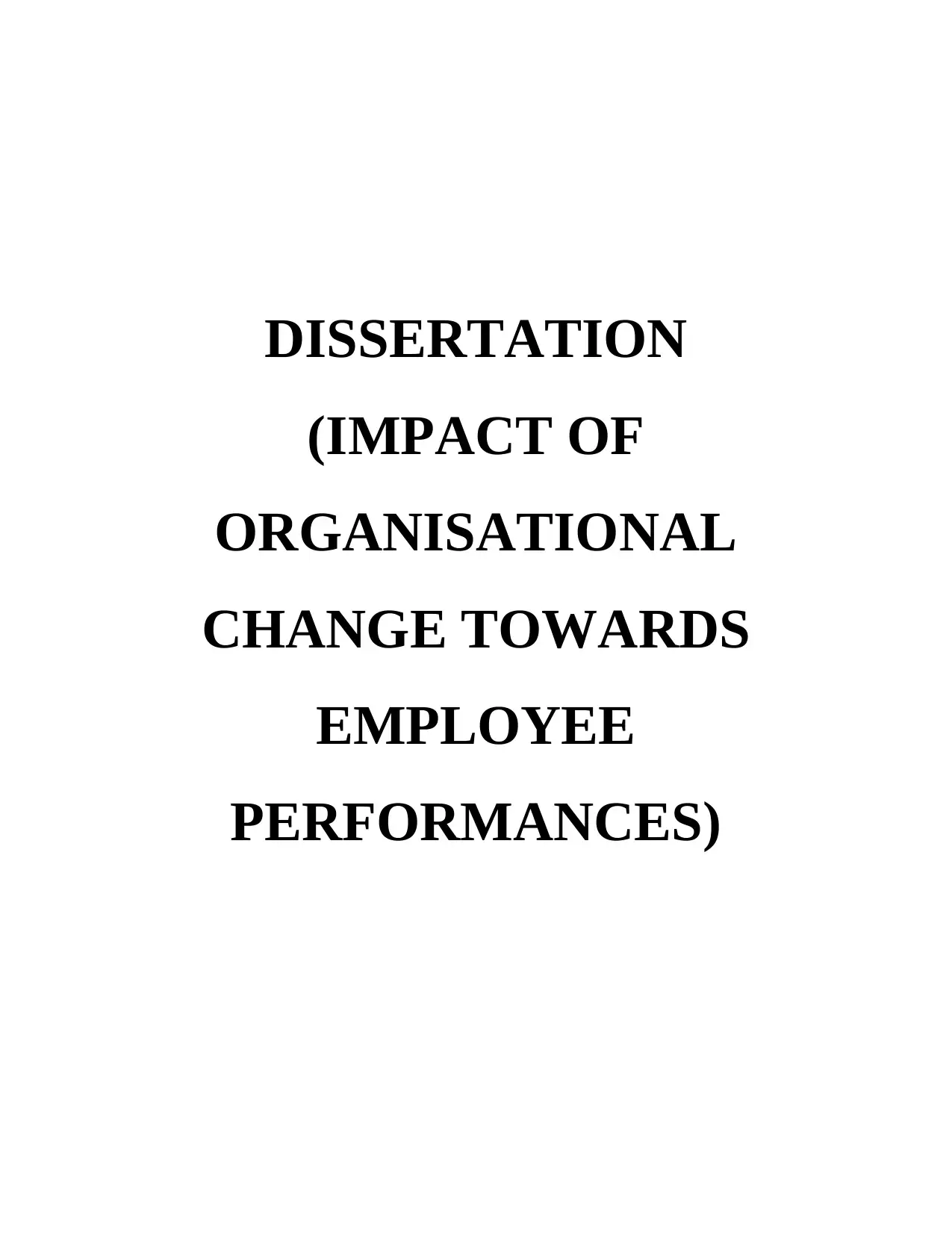
DISSERTATION
(IMPACT OF
ORGANISATIONAL
CHANGE TOWARDS
EMPLOYEE
PERFORMANCES)
(IMPACT OF
ORGANISATIONAL
CHANGE TOWARDS
EMPLOYEE
PERFORMANCES)
Paraphrase This Document
Need a fresh take? Get an instant paraphrase of this document with our AI Paraphraser
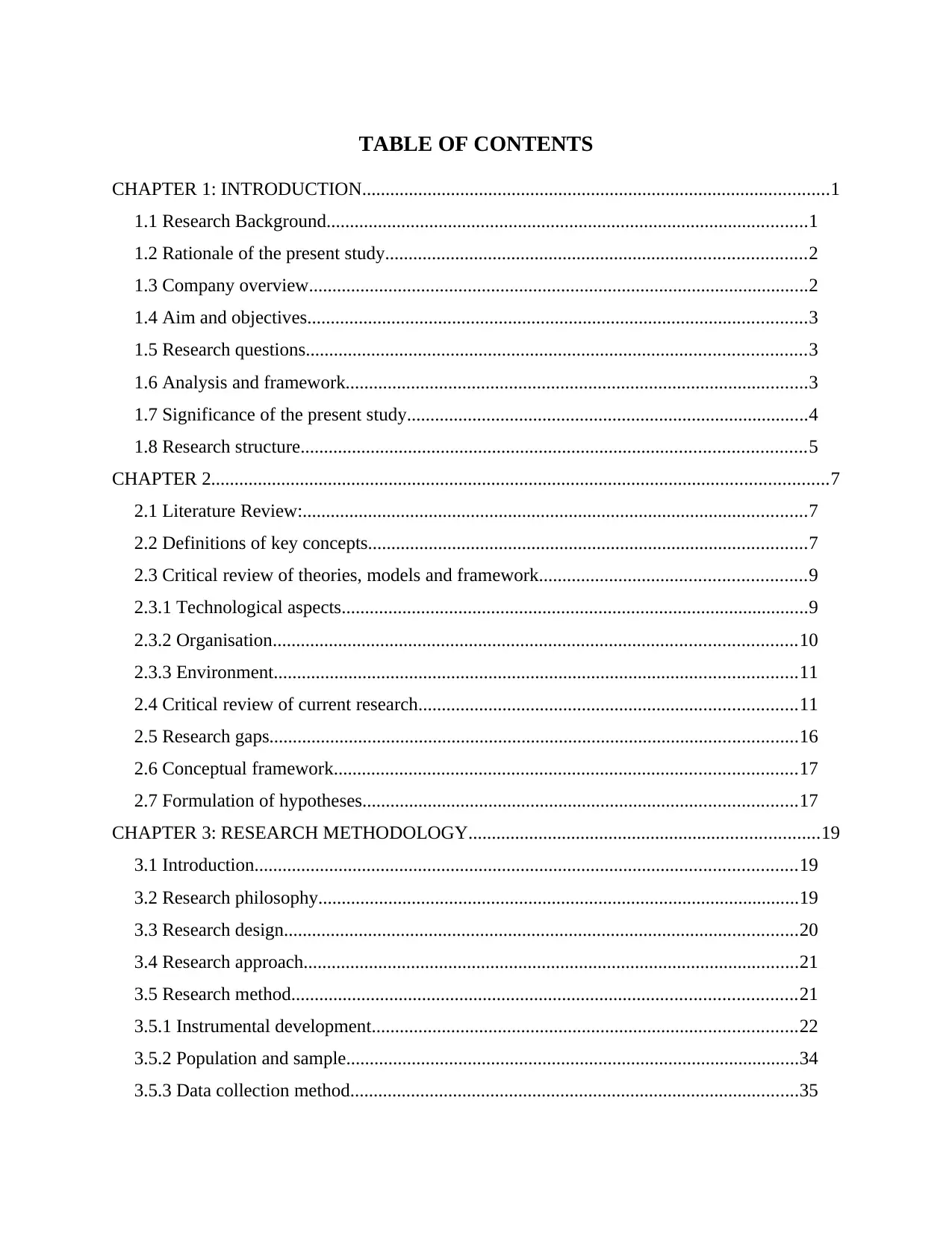
TABLE OF CONTENTS
CHAPTER 1: INTRODUCTION....................................................................................................1
1.1 Research Background.......................................................................................................1
1.2 Rationale of the present study..........................................................................................2
1.3 Company overview...........................................................................................................2
1.4 Aim and objectives...........................................................................................................3
1.5 Research questions...........................................................................................................3
1.6 Analysis and framework...................................................................................................3
1.7 Significance of the present study......................................................................................4
1.8 Research structure............................................................................................................5
CHAPTER 2....................................................................................................................................7
2.1 Literature Review:............................................................................................................7
2.2 Definitions of key concepts..............................................................................................7
2.3 Critical review of theories, models and framework.........................................................9
2.3.1 Technological aspects....................................................................................................9
2.3.2 Organisation................................................................................................................10
2.3.3 Environment................................................................................................................11
2.4 Critical review of current research.................................................................................11
2.5 Research gaps.................................................................................................................16
2.6 Conceptual framework...................................................................................................17
2.7 Formulation of hypotheses.............................................................................................17
CHAPTER 3: RESEARCH METHODOLOGY...........................................................................19
3.1 Introduction....................................................................................................................19
3.2 Research philosophy.......................................................................................................19
3.3 Research design..............................................................................................................20
3.4 Research approach..........................................................................................................21
3.5 Research method............................................................................................................21
3.5.1 Instrumental development...........................................................................................22
3.5.2 Population and sample.................................................................................................34
3.5.3 Data collection method................................................................................................35
CHAPTER 1: INTRODUCTION....................................................................................................1
1.1 Research Background.......................................................................................................1
1.2 Rationale of the present study..........................................................................................2
1.3 Company overview...........................................................................................................2
1.4 Aim and objectives...........................................................................................................3
1.5 Research questions...........................................................................................................3
1.6 Analysis and framework...................................................................................................3
1.7 Significance of the present study......................................................................................4
1.8 Research structure............................................................................................................5
CHAPTER 2....................................................................................................................................7
2.1 Literature Review:............................................................................................................7
2.2 Definitions of key concepts..............................................................................................7
2.3 Critical review of theories, models and framework.........................................................9
2.3.1 Technological aspects....................................................................................................9
2.3.2 Organisation................................................................................................................10
2.3.3 Environment................................................................................................................11
2.4 Critical review of current research.................................................................................11
2.5 Research gaps.................................................................................................................16
2.6 Conceptual framework...................................................................................................17
2.7 Formulation of hypotheses.............................................................................................17
CHAPTER 3: RESEARCH METHODOLOGY...........................................................................19
3.1 Introduction....................................................................................................................19
3.2 Research philosophy.......................................................................................................19
3.3 Research design..............................................................................................................20
3.4 Research approach..........................................................................................................21
3.5 Research method............................................................................................................21
3.5.1 Instrumental development...........................................................................................22
3.5.2 Population and sample.................................................................................................34
3.5.3 Data collection method................................................................................................35
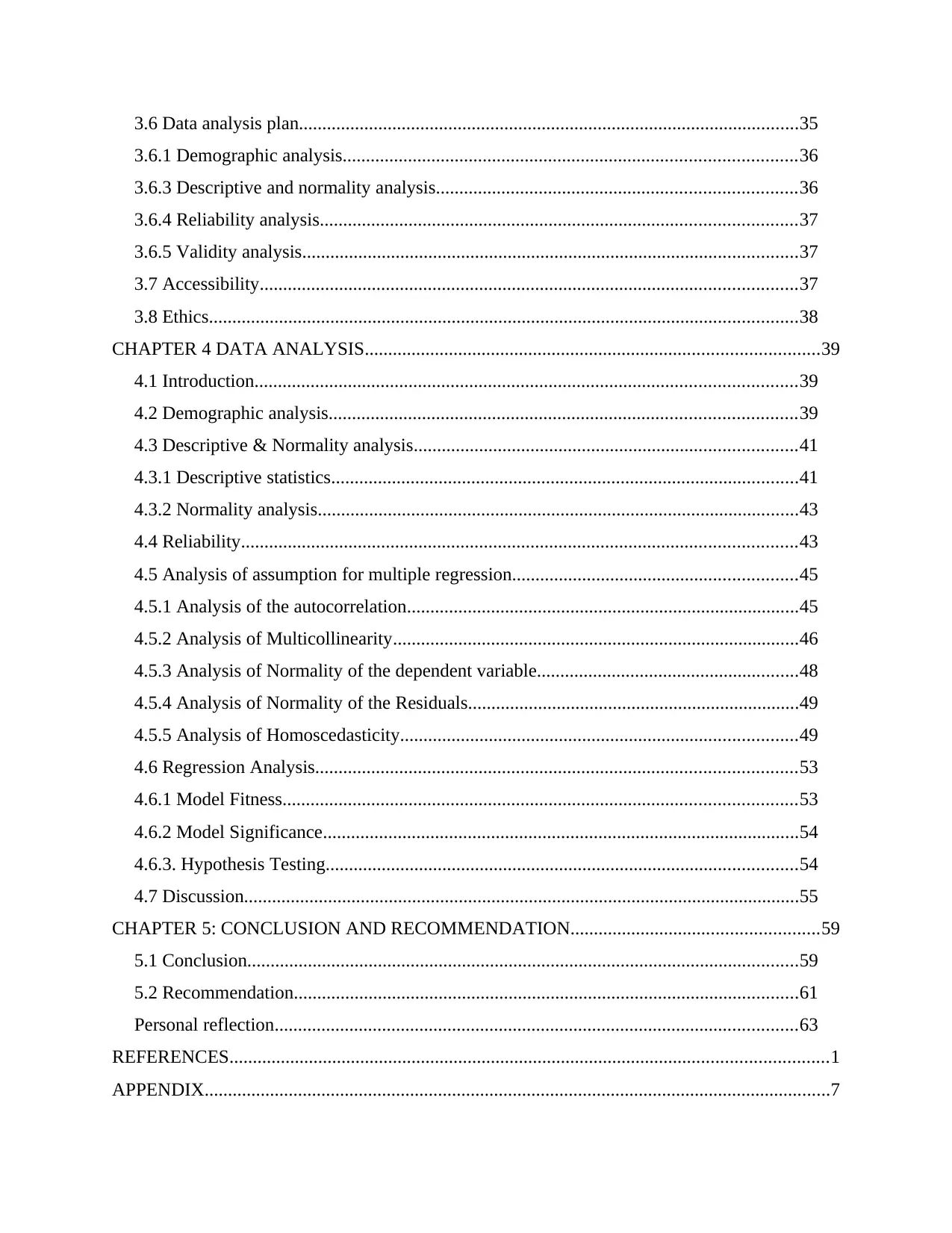
3.6 Data analysis plan...........................................................................................................35
3.6.1 Demographic analysis.................................................................................................36
3.6.3 Descriptive and normality analysis.............................................................................36
3.6.4 Reliability analysis......................................................................................................37
3.6.5 Validity analysis..........................................................................................................37
3.7 Accessibility...................................................................................................................37
3.8 Ethics..............................................................................................................................38
CHAPTER 4 DATA ANALYSIS.................................................................................................39
4.1 Introduction....................................................................................................................39
4.2 Demographic analysis....................................................................................................39
4.3 Descriptive & Normality analysis..................................................................................41
4.3.1 Descriptive statistics....................................................................................................41
4.3.2 Normality analysis.......................................................................................................43
4.4 Reliability.......................................................................................................................43
4.5 Analysis of assumption for multiple regression.............................................................45
4.5.1 Analysis of the autocorrelation....................................................................................45
4.5.2 Analysis of Multicollinearity.......................................................................................46
4.5.3 Analysis of Normality of the dependent variable........................................................48
4.5.4 Analysis of Normality of the Residuals.......................................................................49
4.5.5 Analysis of Homoscedasticity.....................................................................................49
4.6 Regression Analysis.......................................................................................................53
4.6.1 Model Fitness..............................................................................................................53
4.6.2 Model Significance......................................................................................................54
4.6.3. Hypothesis Testing.....................................................................................................54
4.7 Discussion.......................................................................................................................55
CHAPTER 5: CONCLUSION AND RECOMMENDATION.....................................................59
5.1 Conclusion......................................................................................................................59
5.2 Recommendation............................................................................................................61
Personal reflection................................................................................................................63
REFERENCES................................................................................................................................1
APPENDIX......................................................................................................................................7
3.6.1 Demographic analysis.................................................................................................36
3.6.3 Descriptive and normality analysis.............................................................................36
3.6.4 Reliability analysis......................................................................................................37
3.6.5 Validity analysis..........................................................................................................37
3.7 Accessibility...................................................................................................................37
3.8 Ethics..............................................................................................................................38
CHAPTER 4 DATA ANALYSIS.................................................................................................39
4.1 Introduction....................................................................................................................39
4.2 Demographic analysis....................................................................................................39
4.3 Descriptive & Normality analysis..................................................................................41
4.3.1 Descriptive statistics....................................................................................................41
4.3.2 Normality analysis.......................................................................................................43
4.4 Reliability.......................................................................................................................43
4.5 Analysis of assumption for multiple regression.............................................................45
4.5.1 Analysis of the autocorrelation....................................................................................45
4.5.2 Analysis of Multicollinearity.......................................................................................46
4.5.3 Analysis of Normality of the dependent variable........................................................48
4.5.4 Analysis of Normality of the Residuals.......................................................................49
4.5.5 Analysis of Homoscedasticity.....................................................................................49
4.6 Regression Analysis.......................................................................................................53
4.6.1 Model Fitness..............................................................................................................53
4.6.2 Model Significance......................................................................................................54
4.6.3. Hypothesis Testing.....................................................................................................54
4.7 Discussion.......................................................................................................................55
CHAPTER 5: CONCLUSION AND RECOMMENDATION.....................................................59
5.1 Conclusion......................................................................................................................59
5.2 Recommendation............................................................................................................61
Personal reflection................................................................................................................63
REFERENCES................................................................................................................................1
APPENDIX......................................................................................................................................7
⊘ This is a preview!⊘
Do you want full access?
Subscribe today to unlock all pages.

Trusted by 1+ million students worldwide

Paraphrase This Document
Need a fresh take? Get an instant paraphrase of this document with our AI Paraphraser
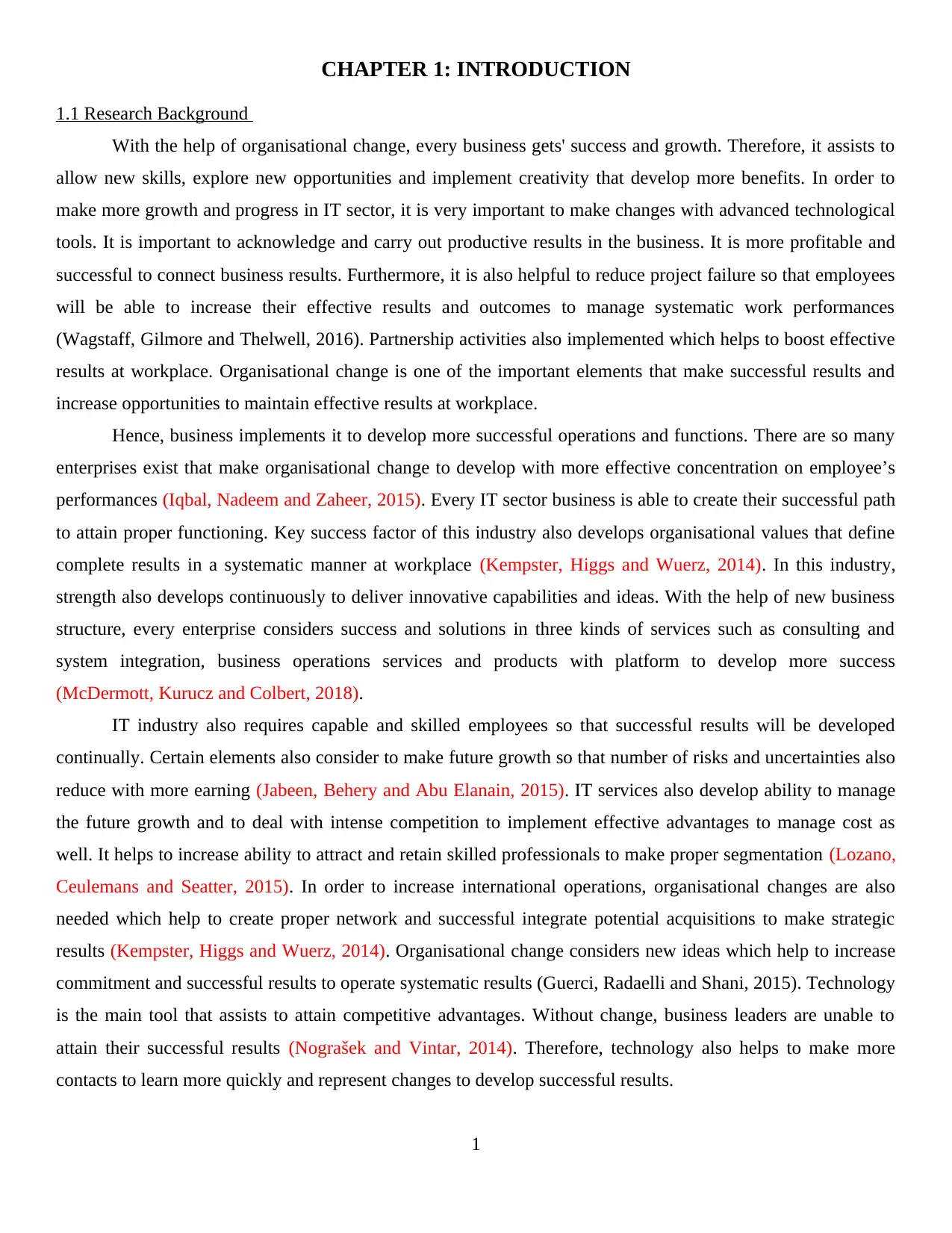
CHAPTER 1: INTRODUCTION
1.1 Research Background
With the help of organisational change, every business gets' success and growth. Therefore, it assists to
allow new skills, explore new opportunities and implement creativity that develop more benefits. In order to
make more growth and progress in IT sector, it is very important to make changes with advanced technological
tools. It is important to acknowledge and carry out productive results in the business. It is more profitable and
successful to connect business results. Furthermore, it is also helpful to reduce project failure so that employees
will be able to increase their effective results and outcomes to manage systematic work performances
(Wagstaff, Gilmore and Thelwell, 2016). Partnership activities also implemented which helps to boost effective
results at workplace. Organisational change is one of the important elements that make successful results and
increase opportunities to maintain effective results at workplace.
Hence, business implements it to develop more successful operations and functions. There are so many
enterprises exist that make organisational change to develop with more effective concentration on employee’s
performances (Iqbal, Nadeem and Zaheer, 2015). Every IT sector business is able to create their successful path
to attain proper functioning. Key success factor of this industry also develops organisational values that define
complete results in a systematic manner at workplace (Kempster, Higgs and Wuerz, 2014). In this industry,
strength also develops continuously to deliver innovative capabilities and ideas. With the help of new business
structure, every enterprise considers success and solutions in three kinds of services such as consulting and
system integration, business operations services and products with platform to develop more success
(McDermott, Kurucz and Colbert, 2018).
IT industry also requires capable and skilled employees so that successful results will be developed
continually. Certain elements also consider to make future growth so that number of risks and uncertainties also
reduce with more earning (Jabeen, Behery and Abu Elanain, 2015). IT services also develop ability to manage
the future growth and to deal with intense competition to implement effective advantages to manage cost as
well. It helps to increase ability to attract and retain skilled professionals to make proper segmentation (Lozano,
Ceulemans and Seatter, 2015). In order to increase international operations, organisational changes are also
needed which help to create proper network and successful integrate potential acquisitions to make strategic
results (Kempster, Higgs and Wuerz, 2014). Organisational change considers new ideas which help to increase
commitment and successful results to operate systematic results (Guerci, Radaelli and Shani, 2015). Technology
is the main tool that assists to attain competitive advantages. Without change, business leaders are unable to
attain their successful results (Nograšek and Vintar, 2014). Therefore, technology also helps to make more
contacts to learn more quickly and represent changes to develop successful results.
1
1.1 Research Background
With the help of organisational change, every business gets' success and growth. Therefore, it assists to
allow new skills, explore new opportunities and implement creativity that develop more benefits. In order to
make more growth and progress in IT sector, it is very important to make changes with advanced technological
tools. It is important to acknowledge and carry out productive results in the business. It is more profitable and
successful to connect business results. Furthermore, it is also helpful to reduce project failure so that employees
will be able to increase their effective results and outcomes to manage systematic work performances
(Wagstaff, Gilmore and Thelwell, 2016). Partnership activities also implemented which helps to boost effective
results at workplace. Organisational change is one of the important elements that make successful results and
increase opportunities to maintain effective results at workplace.
Hence, business implements it to develop more successful operations and functions. There are so many
enterprises exist that make organisational change to develop with more effective concentration on employee’s
performances (Iqbal, Nadeem and Zaheer, 2015). Every IT sector business is able to create their successful path
to attain proper functioning. Key success factor of this industry also develops organisational values that define
complete results in a systematic manner at workplace (Kempster, Higgs and Wuerz, 2014). In this industry,
strength also develops continuously to deliver innovative capabilities and ideas. With the help of new business
structure, every enterprise considers success and solutions in three kinds of services such as consulting and
system integration, business operations services and products with platform to develop more success
(McDermott, Kurucz and Colbert, 2018).
IT industry also requires capable and skilled employees so that successful results will be developed
continually. Certain elements also consider to make future growth so that number of risks and uncertainties also
reduce with more earning (Jabeen, Behery and Abu Elanain, 2015). IT services also develop ability to manage
the future growth and to deal with intense competition to implement effective advantages to manage cost as
well. It helps to increase ability to attract and retain skilled professionals to make proper segmentation (Lozano,
Ceulemans and Seatter, 2015). In order to increase international operations, organisational changes are also
needed which help to create proper network and successful integrate potential acquisitions to make strategic
results (Kempster, Higgs and Wuerz, 2014). Organisational change considers new ideas which help to increase
commitment and successful results to operate systematic results (Guerci, Radaelli and Shani, 2015). Technology
is the main tool that assists to attain competitive advantages. Without change, business leaders are unable to
attain their successful results (Nograšek and Vintar, 2014). Therefore, technology also helps to make more
contacts to learn more quickly and represent changes to develop successful results.
1
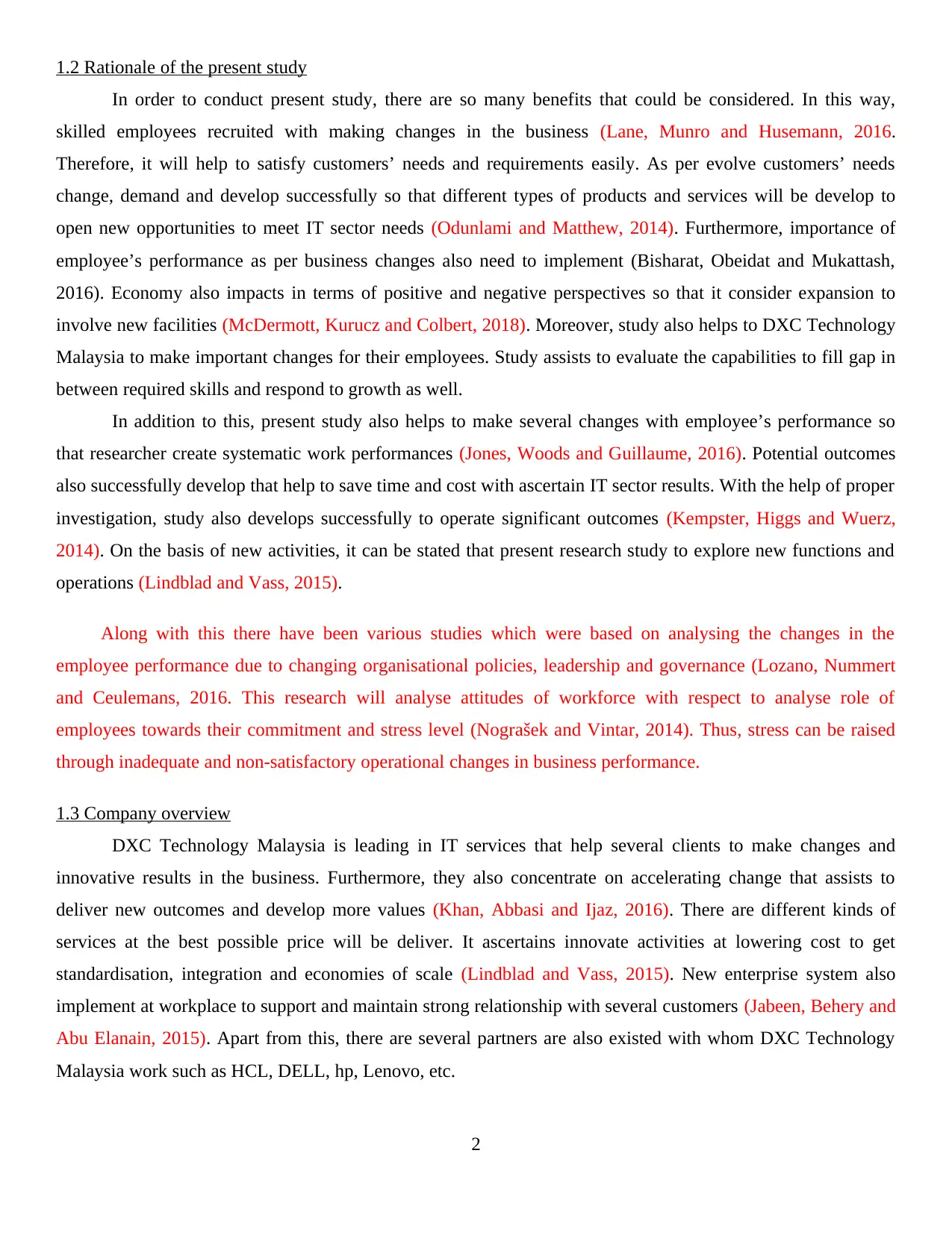
1.2 Rationale of the present study
In order to conduct present study, there are so many benefits that could be considered. In this way,
skilled employees recruited with making changes in the business (Lane, Munro and Husemann, 2016.
Therefore, it will help to satisfy customers’ needs and requirements easily. As per evolve customers’ needs
change, demand and develop successfully so that different types of products and services will be develop to
open new opportunities to meet IT sector needs (Odunlami and Matthew, 2014). Furthermore, importance of
employee’s performance as per business changes also need to implement (Bisharat, Obeidat and Mukattash,
2016). Economy also impacts in terms of positive and negative perspectives so that it consider expansion to
involve new facilities (McDermott, Kurucz and Colbert, 2018). Moreover, study also helps to DXC Technology
Malaysia to make important changes for their employees. Study assists to evaluate the capabilities to fill gap in
between required skills and respond to growth as well.
In addition to this, present study also helps to make several changes with employee’s performance so
that researcher create systematic work performances (Jones, Woods and Guillaume, 2016). Potential outcomes
also successfully develop that help to save time and cost with ascertain IT sector results. With the help of proper
investigation, study also develops successfully to operate significant outcomes (Kempster, Higgs and Wuerz,
2014). On the basis of new activities, it can be stated that present research study to explore new functions and
operations (Lindblad and Vass, 2015).
Along with this there have been various studies which were based on analysing the changes in the
employee performance due to changing organisational policies, leadership and governance (Lozano, Nummert
and Ceulemans, 2016. This research will analyse attitudes of workforce with respect to analyse role of
employees towards their commitment and stress level (Nograšek and Vintar, 2014). Thus, stress can be raised
through inadequate and non-satisfactory operational changes in business performance.
1.3 Company overview
DXC Technology Malaysia is leading in IT services that help several clients to make changes and
innovative results in the business. Furthermore, they also concentrate on accelerating change that assists to
deliver new outcomes and develop more values (Khan, Abbasi and Ijaz, 2016). There are different kinds of
services at the best possible price will be deliver. It ascertains innovate activities at lowering cost to get
standardisation, integration and economies of scale (Lindblad and Vass, 2015). New enterprise system also
implement at workplace to support and maintain strong relationship with several customers (Jabeen, Behery and
Abu Elanain, 2015). Apart from this, there are several partners are also existed with whom DXC Technology
Malaysia work such as HCL, DELL, hp, Lenovo, etc.
2
In order to conduct present study, there are so many benefits that could be considered. In this way,
skilled employees recruited with making changes in the business (Lane, Munro and Husemann, 2016.
Therefore, it will help to satisfy customers’ needs and requirements easily. As per evolve customers’ needs
change, demand and develop successfully so that different types of products and services will be develop to
open new opportunities to meet IT sector needs (Odunlami and Matthew, 2014). Furthermore, importance of
employee’s performance as per business changes also need to implement (Bisharat, Obeidat and Mukattash,
2016). Economy also impacts in terms of positive and negative perspectives so that it consider expansion to
involve new facilities (McDermott, Kurucz and Colbert, 2018). Moreover, study also helps to DXC Technology
Malaysia to make important changes for their employees. Study assists to evaluate the capabilities to fill gap in
between required skills and respond to growth as well.
In addition to this, present study also helps to make several changes with employee’s performance so
that researcher create systematic work performances (Jones, Woods and Guillaume, 2016). Potential outcomes
also successfully develop that help to save time and cost with ascertain IT sector results. With the help of proper
investigation, study also develops successfully to operate significant outcomes (Kempster, Higgs and Wuerz,
2014). On the basis of new activities, it can be stated that present research study to explore new functions and
operations (Lindblad and Vass, 2015).
Along with this there have been various studies which were based on analysing the changes in the
employee performance due to changing organisational policies, leadership and governance (Lozano, Nummert
and Ceulemans, 2016. This research will analyse attitudes of workforce with respect to analyse role of
employees towards their commitment and stress level (Nograšek and Vintar, 2014). Thus, stress can be raised
through inadequate and non-satisfactory operational changes in business performance.
1.3 Company overview
DXC Technology Malaysia is leading in IT services that help several clients to make changes and
innovative results in the business. Furthermore, they also concentrate on accelerating change that assists to
deliver new outcomes and develop more values (Khan, Abbasi and Ijaz, 2016). There are different kinds of
services at the best possible price will be deliver. It ascertains innovate activities at lowering cost to get
standardisation, integration and economies of scale (Lindblad and Vass, 2015). New enterprise system also
implement at workplace to support and maintain strong relationship with several customers (Jabeen, Behery and
Abu Elanain, 2015). Apart from this, there are several partners are also existed with whom DXC Technology
Malaysia work such as HCL, DELL, hp, Lenovo, etc.
2
⊘ This is a preview!⊘
Do you want full access?
Subscribe today to unlock all pages.

Trusted by 1+ million students worldwide
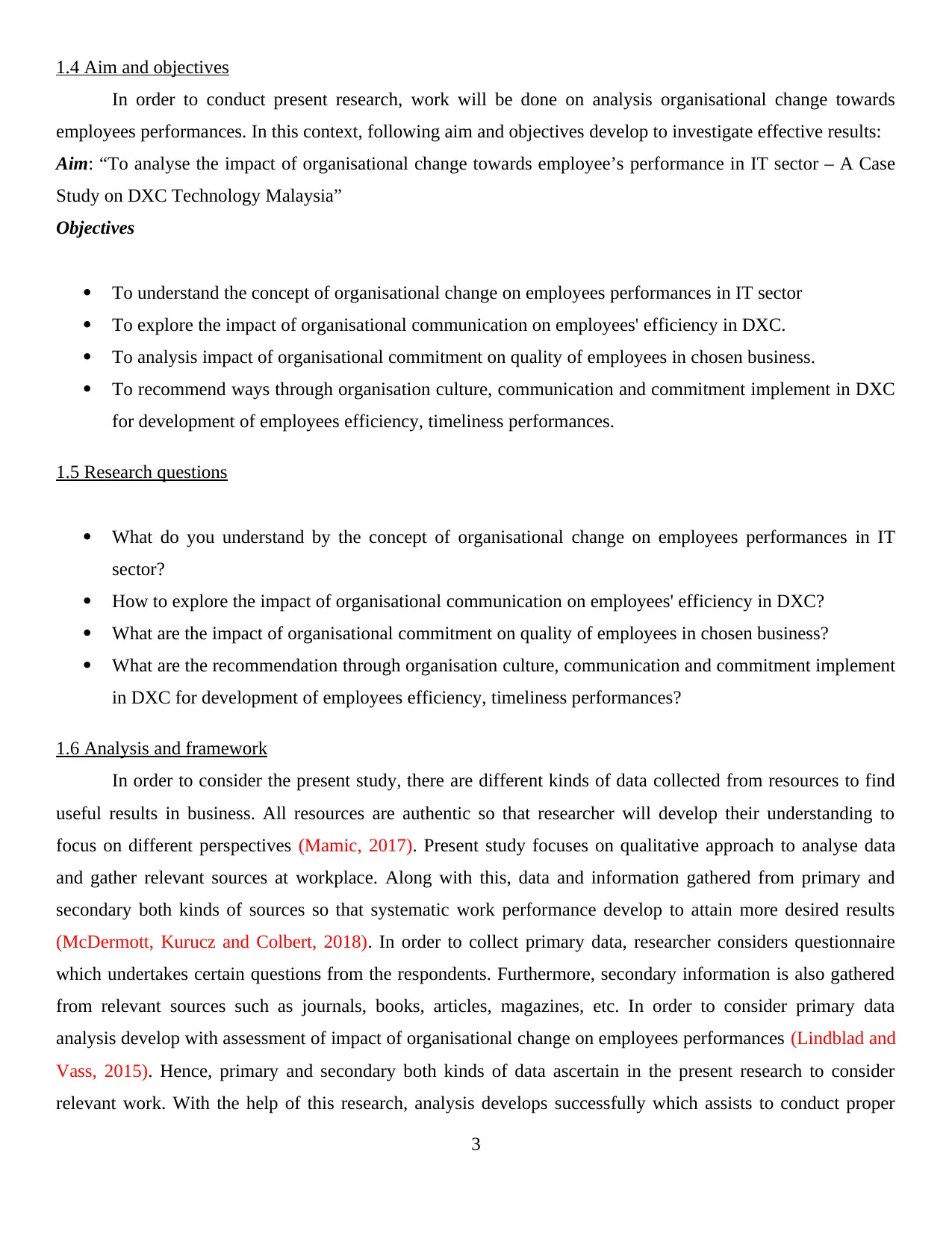
1.4 Aim and objectives
In order to conduct present research, work will be done on analysis organisational change towards
employees performances. In this context, following aim and objectives develop to investigate effective results:
Aim: “To analyse the impact of organisational change towards employee’s performance in IT sector – A Case
Study on DXC Technology Malaysia”
Objectives
To understand the concept of organisational change on employees performances in IT sector
To explore the impact of organisational communication on employees' efficiency in DXC.
To analysis impact of organisational commitment on quality of employees in chosen business.
To recommend ways through organisation culture, communication and commitment implement in DXC
for development of employees efficiency, timeliness performances.
1.5 Research questions
What do you understand by the concept of organisational change on employees performances in IT
sector?
How to explore the impact of organisational communication on employees' efficiency in DXC?
What are the impact of organisational commitment on quality of employees in chosen business?
What are the recommendation through organisation culture, communication and commitment implement
in DXC for development of employees efficiency, timeliness performances?
1.6 Analysis and framework
In order to consider the present study, there are different kinds of data collected from resources to find
useful results in business. All resources are authentic so that researcher will develop their understanding to
focus on different perspectives (Mamic, 2017). Present study focuses on qualitative approach to analyse data
and gather relevant sources at workplace. Along with this, data and information gathered from primary and
secondary both kinds of sources so that systematic work performance develop to attain more desired results
(McDermott, Kurucz and Colbert, 2018). In order to collect primary data, researcher considers questionnaire
which undertakes certain questions from the respondents. Furthermore, secondary information is also gathered
from relevant sources such as journals, books, articles, magazines, etc. In order to consider primary data
analysis develop with assessment of impact of organisational change on employees performances (Lindblad and
Vass, 2015). Hence, primary and secondary both kinds of data ascertain in the present research to consider
relevant work. With the help of this research, analysis develops successfully which assists to conduct proper
3
In order to conduct present research, work will be done on analysis organisational change towards
employees performances. In this context, following aim and objectives develop to investigate effective results:
Aim: “To analyse the impact of organisational change towards employee’s performance in IT sector – A Case
Study on DXC Technology Malaysia”
Objectives
To understand the concept of organisational change on employees performances in IT sector
To explore the impact of organisational communication on employees' efficiency in DXC.
To analysis impact of organisational commitment on quality of employees in chosen business.
To recommend ways through organisation culture, communication and commitment implement in DXC
for development of employees efficiency, timeliness performances.
1.5 Research questions
What do you understand by the concept of organisational change on employees performances in IT
sector?
How to explore the impact of organisational communication on employees' efficiency in DXC?
What are the impact of organisational commitment on quality of employees in chosen business?
What are the recommendation through organisation culture, communication and commitment implement
in DXC for development of employees efficiency, timeliness performances?
1.6 Analysis and framework
In order to consider the present study, there are different kinds of data collected from resources to find
useful results in business. All resources are authentic so that researcher will develop their understanding to
focus on different perspectives (Mamic, 2017). Present study focuses on qualitative approach to analyse data
and gather relevant sources at workplace. Along with this, data and information gathered from primary and
secondary both kinds of sources so that systematic work performance develop to attain more desired results
(McDermott, Kurucz and Colbert, 2018). In order to collect primary data, researcher considers questionnaire
which undertakes certain questions from the respondents. Furthermore, secondary information is also gathered
from relevant sources such as journals, books, articles, magazines, etc. In order to consider primary data
analysis develop with assessment of impact of organisational change on employees performances (Lindblad and
Vass, 2015). Hence, primary and secondary both kinds of data ascertain in the present research to consider
relevant work. With the help of this research, analysis develops successfully which assists to conduct proper
3
Paraphrase This Document
Need a fresh take? Get an instant paraphrase of this document with our AI Paraphraser
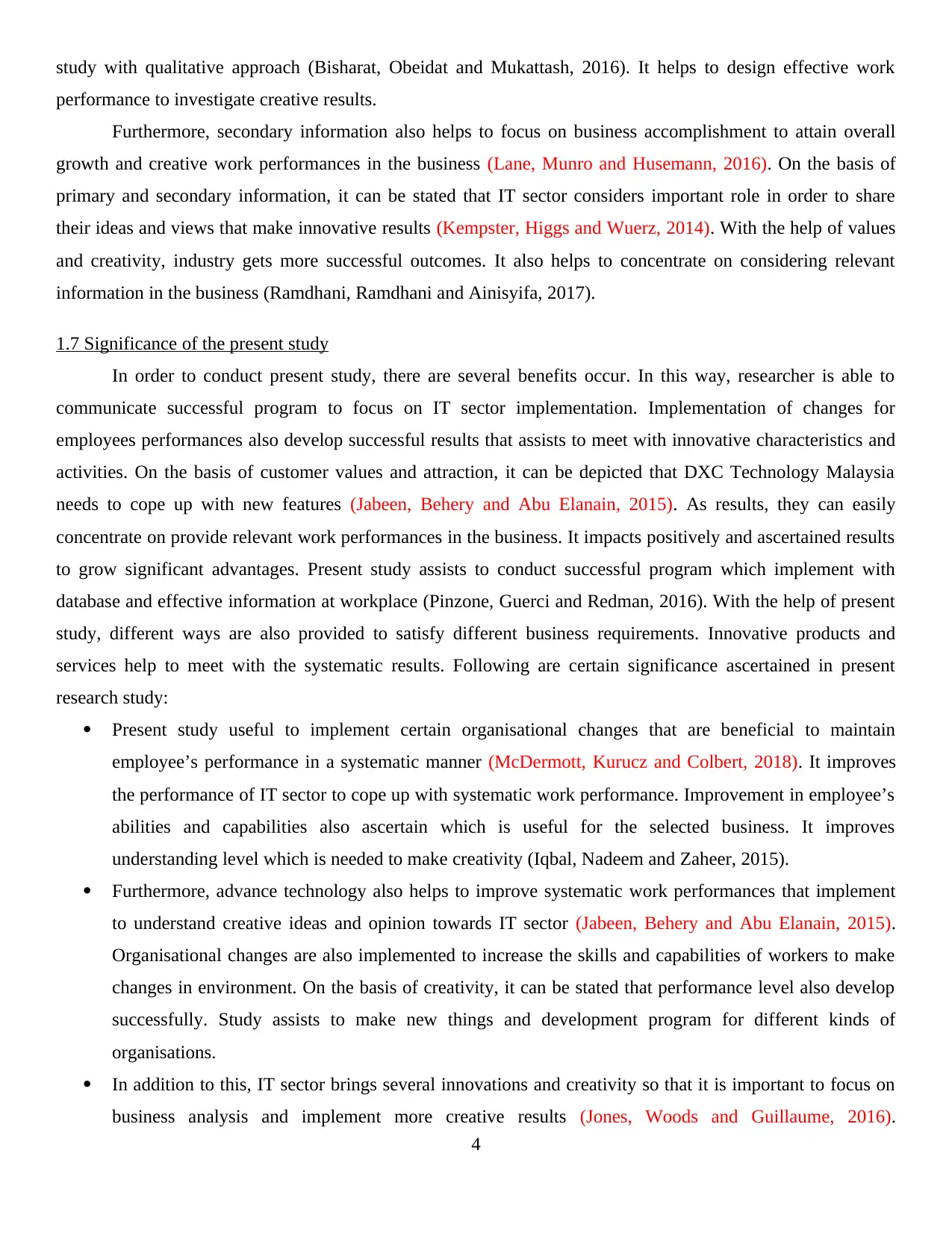
study with qualitative approach (Bisharat, Obeidat and Mukattash, 2016). It helps to design effective work
performance to investigate creative results.
Furthermore, secondary information also helps to focus on business accomplishment to attain overall
growth and creative work performances in the business (Lane, Munro and Husemann, 2016). On the basis of
primary and secondary information, it can be stated that IT sector considers important role in order to share
their ideas and views that make innovative results (Kempster, Higgs and Wuerz, 2014). With the help of values
and creativity, industry gets more successful outcomes. It also helps to concentrate on considering relevant
information in the business (Ramdhani, Ramdhani and Ainisyifa, 2017).
1.7 Significance of the present study
In order to conduct present study, there are several benefits occur. In this way, researcher is able to
communicate successful program to focus on IT sector implementation. Implementation of changes for
employees performances also develop successful results that assists to meet with innovative characteristics and
activities. On the basis of customer values and attraction, it can be depicted that DXC Technology Malaysia
needs to cope up with new features (Jabeen, Behery and Abu Elanain, 2015). As results, they can easily
concentrate on provide relevant work performances in the business. It impacts positively and ascertained results
to grow significant advantages. Present study assists to conduct successful program which implement with
database and effective information at workplace (Pinzone, Guerci and Redman, 2016). With the help of present
study, different ways are also provided to satisfy different business requirements. Innovative products and
services help to meet with the systematic results. Following are certain significance ascertained in present
research study:
Present study useful to implement certain organisational changes that are beneficial to maintain
employee’s performance in a systematic manner (McDermott, Kurucz and Colbert, 2018). It improves
the performance of IT sector to cope up with systematic work performance. Improvement in employee’s
abilities and capabilities also ascertain which is useful for the selected business. It improves
understanding level which is needed to make creativity (Iqbal, Nadeem and Zaheer, 2015).
Furthermore, advance technology also helps to improve systematic work performances that implement
to understand creative ideas and opinion towards IT sector (Jabeen, Behery and Abu Elanain, 2015).
Organisational changes are also implemented to increase the skills and capabilities of workers to make
changes in environment. On the basis of creativity, it can be stated that performance level also develop
successfully. Study assists to make new things and development program for different kinds of
organisations.
In addition to this, IT sector brings several innovations and creativity so that it is important to focus on
business analysis and implement more creative results (Jones, Woods and Guillaume, 2016).
4
performance to investigate creative results.
Furthermore, secondary information also helps to focus on business accomplishment to attain overall
growth and creative work performances in the business (Lane, Munro and Husemann, 2016). On the basis of
primary and secondary information, it can be stated that IT sector considers important role in order to share
their ideas and views that make innovative results (Kempster, Higgs and Wuerz, 2014). With the help of values
and creativity, industry gets more successful outcomes. It also helps to concentrate on considering relevant
information in the business (Ramdhani, Ramdhani and Ainisyifa, 2017).
1.7 Significance of the present study
In order to conduct present study, there are several benefits occur. In this way, researcher is able to
communicate successful program to focus on IT sector implementation. Implementation of changes for
employees performances also develop successful results that assists to meet with innovative characteristics and
activities. On the basis of customer values and attraction, it can be depicted that DXC Technology Malaysia
needs to cope up with new features (Jabeen, Behery and Abu Elanain, 2015). As results, they can easily
concentrate on provide relevant work performances in the business. It impacts positively and ascertained results
to grow significant advantages. Present study assists to conduct successful program which implement with
database and effective information at workplace (Pinzone, Guerci and Redman, 2016). With the help of present
study, different ways are also provided to satisfy different business requirements. Innovative products and
services help to meet with the systematic results. Following are certain significance ascertained in present
research study:
Present study useful to implement certain organisational changes that are beneficial to maintain
employee’s performance in a systematic manner (McDermott, Kurucz and Colbert, 2018). It improves
the performance of IT sector to cope up with systematic work performance. Improvement in employee’s
abilities and capabilities also ascertain which is useful for the selected business. It improves
understanding level which is needed to make creativity (Iqbal, Nadeem and Zaheer, 2015).
Furthermore, advance technology also helps to improve systematic work performances that implement
to understand creative ideas and opinion towards IT sector (Jabeen, Behery and Abu Elanain, 2015).
Organisational changes are also implemented to increase the skills and capabilities of workers to make
changes in environment. On the basis of creativity, it can be stated that performance level also develop
successfully. Study assists to make new things and development program for different kinds of
organisations.
In addition to this, IT sector brings several innovations and creativity so that it is important to focus on
business analysis and implement more creative results (Jones, Woods and Guillaume, 2016).
4
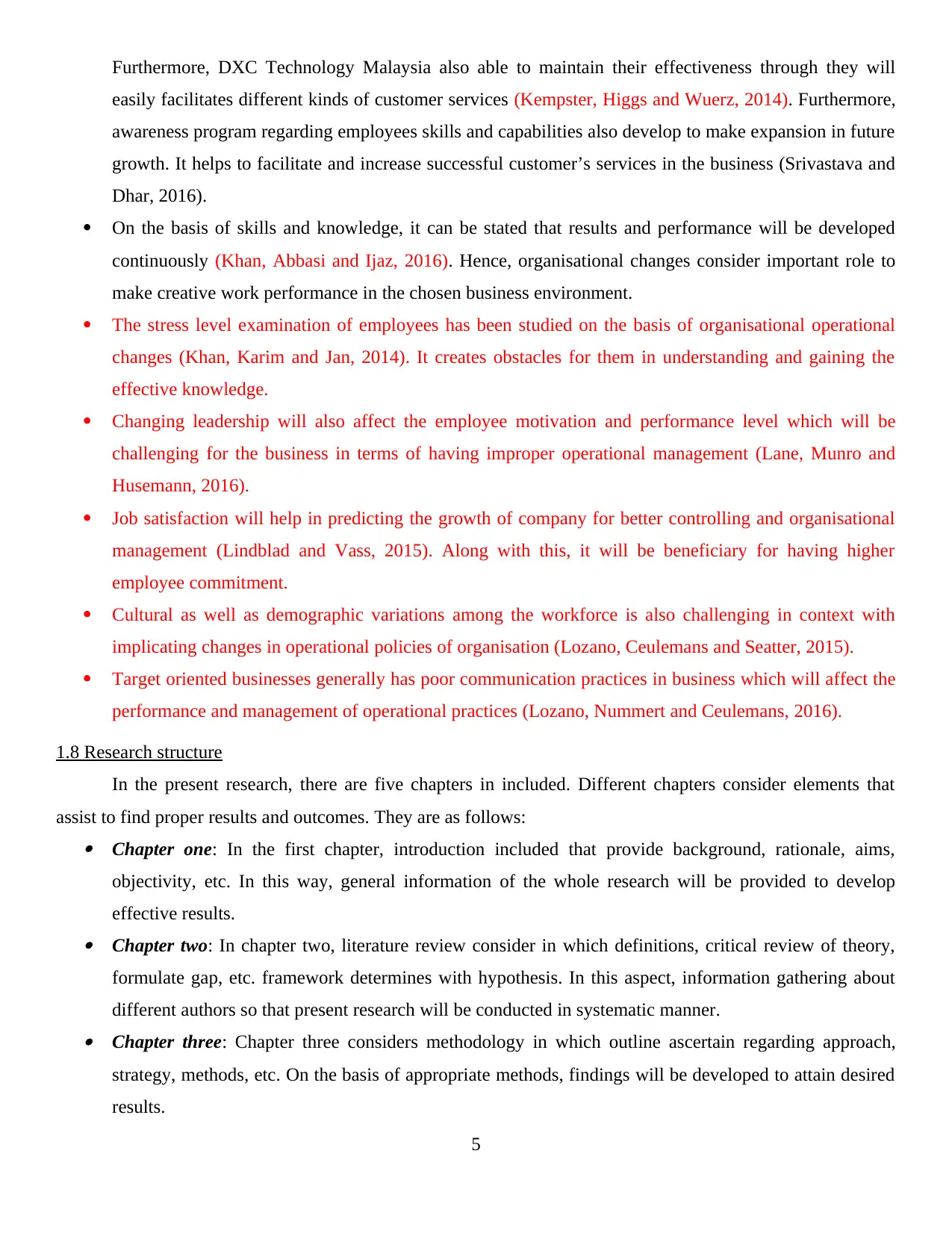
Furthermore, DXC Technology Malaysia also able to maintain their effectiveness through they will
easily facilitates different kinds of customer services (Kempster, Higgs and Wuerz, 2014). Furthermore,
awareness program regarding employees skills and capabilities also develop to make expansion in future
growth. It helps to facilitate and increase successful customer’s services in the business (Srivastava and
Dhar, 2016).
On the basis of skills and knowledge, it can be stated that results and performance will be developed
continuously (Khan, Abbasi and Ijaz, 2016). Hence, organisational changes consider important role to
make creative work performance in the chosen business environment.
The stress level examination of employees has been studied on the basis of organisational operational
changes (Khan, Karim and Jan, 2014). It creates obstacles for them in understanding and gaining the
effective knowledge.
Changing leadership will also affect the employee motivation and performance level which will be
challenging for the business in terms of having improper operational management (Lane, Munro and
Husemann, 2016).
Job satisfaction will help in predicting the growth of company for better controlling and organisational
management (Lindblad and Vass, 2015). Along with this, it will be beneficiary for having higher
employee commitment.
Cultural as well as demographic variations among the workforce is also challenging in context with
implicating changes in operational policies of organisation (Lozano, Ceulemans and Seatter, 2015).
Target oriented businesses generally has poor communication practices in business which will affect the
performance and management of operational practices (Lozano, Nummert and Ceulemans, 2016).
1.8 Research structure
In the present research, there are five chapters in included. Different chapters consider elements that
assist to find proper results and outcomes. They are as follows:
Chapter one: In the first chapter, introduction included that provide background, rationale, aims,
objectivity, etc. In this way, general information of the whole research will be provided to develop
effective results.
Chapter two: In chapter two, literature review consider in which definitions, critical review of theory,
formulate gap, etc. framework determines with hypothesis. In this aspect, information gathering about
different authors so that present research will be conducted in systematic manner.
Chapter three: Chapter three considers methodology in which outline ascertain regarding approach,
strategy, methods, etc. On the basis of appropriate methods, findings will be developed to attain desired
results.
5
easily facilitates different kinds of customer services (Kempster, Higgs and Wuerz, 2014). Furthermore,
awareness program regarding employees skills and capabilities also develop to make expansion in future
growth. It helps to facilitate and increase successful customer’s services in the business (Srivastava and
Dhar, 2016).
On the basis of skills and knowledge, it can be stated that results and performance will be developed
continuously (Khan, Abbasi and Ijaz, 2016). Hence, organisational changes consider important role to
make creative work performance in the chosen business environment.
The stress level examination of employees has been studied on the basis of organisational operational
changes (Khan, Karim and Jan, 2014). It creates obstacles for them in understanding and gaining the
effective knowledge.
Changing leadership will also affect the employee motivation and performance level which will be
challenging for the business in terms of having improper operational management (Lane, Munro and
Husemann, 2016).
Job satisfaction will help in predicting the growth of company for better controlling and organisational
management (Lindblad and Vass, 2015). Along with this, it will be beneficiary for having higher
employee commitment.
Cultural as well as demographic variations among the workforce is also challenging in context with
implicating changes in operational policies of organisation (Lozano, Ceulemans and Seatter, 2015).
Target oriented businesses generally has poor communication practices in business which will affect the
performance and management of operational practices (Lozano, Nummert and Ceulemans, 2016).
1.8 Research structure
In the present research, there are five chapters in included. Different chapters consider elements that
assist to find proper results and outcomes. They are as follows:
Chapter one: In the first chapter, introduction included that provide background, rationale, aims,
objectivity, etc. In this way, general information of the whole research will be provided to develop
effective results.
Chapter two: In chapter two, literature review consider in which definitions, critical review of theory,
formulate gap, etc. framework determines with hypothesis. In this aspect, information gathering about
different authors so that present research will be conducted in systematic manner.
Chapter three: Chapter three considers methodology in which outline ascertain regarding approach,
strategy, methods, etc. On the basis of appropriate methods, findings will be developed to attain desired
results.
5
⊘ This is a preview!⊘
Do you want full access?
Subscribe today to unlock all pages.

Trusted by 1+ million students worldwide
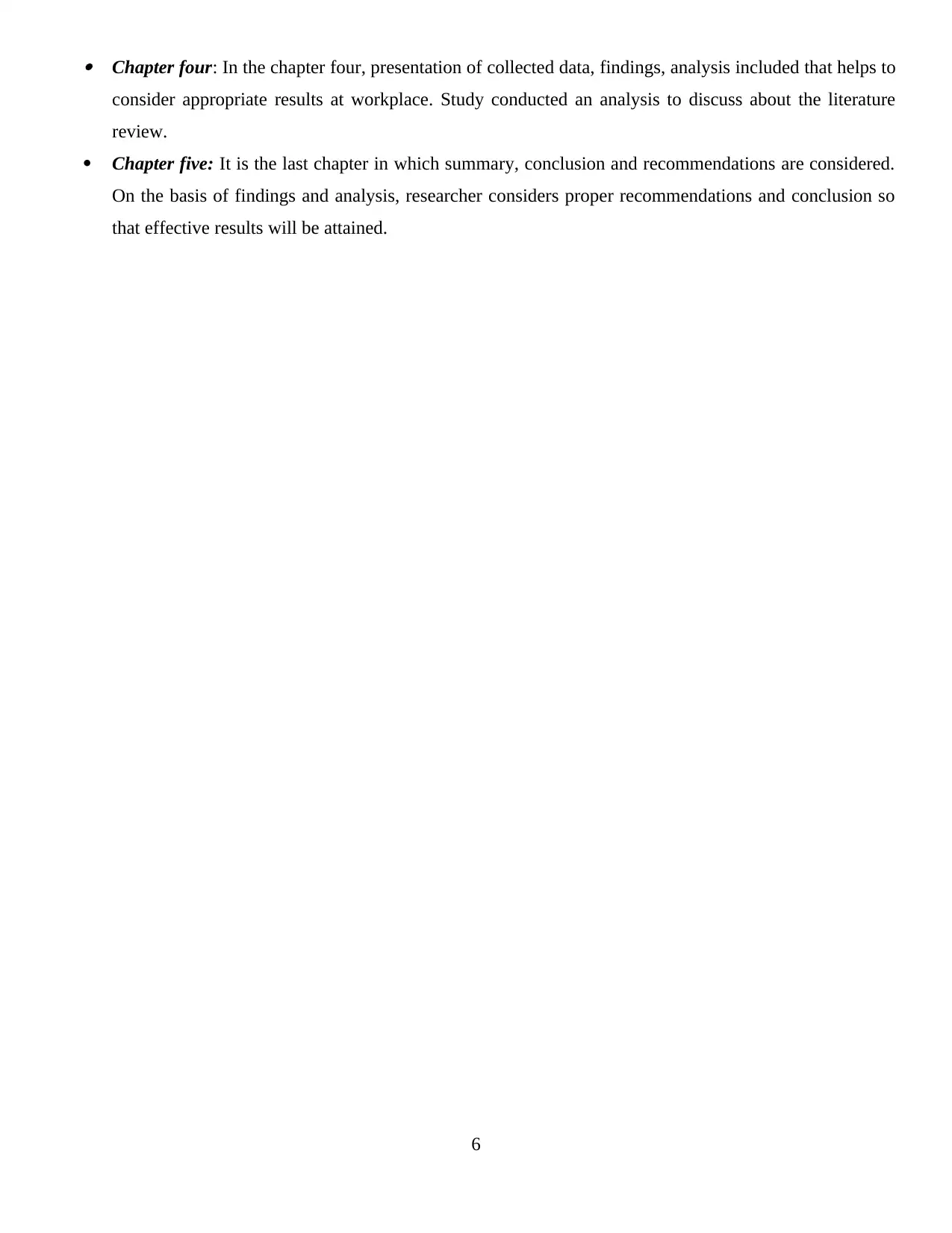
Chapter four: In the chapter four, presentation of collected data, findings, analysis included that helps to
consider appropriate results at workplace. Study conducted an analysis to discuss about the literature
review.
Chapter five: It is the last chapter in which summary, conclusion and recommendations are considered.
On the basis of findings and analysis, researcher considers proper recommendations and conclusion so
that effective results will be attained.
6
consider appropriate results at workplace. Study conducted an analysis to discuss about the literature
review.
Chapter five: It is the last chapter in which summary, conclusion and recommendations are considered.
On the basis of findings and analysis, researcher considers proper recommendations and conclusion so
that effective results will be attained.
6
Paraphrase This Document
Need a fresh take? Get an instant paraphrase of this document with our AI Paraphraser
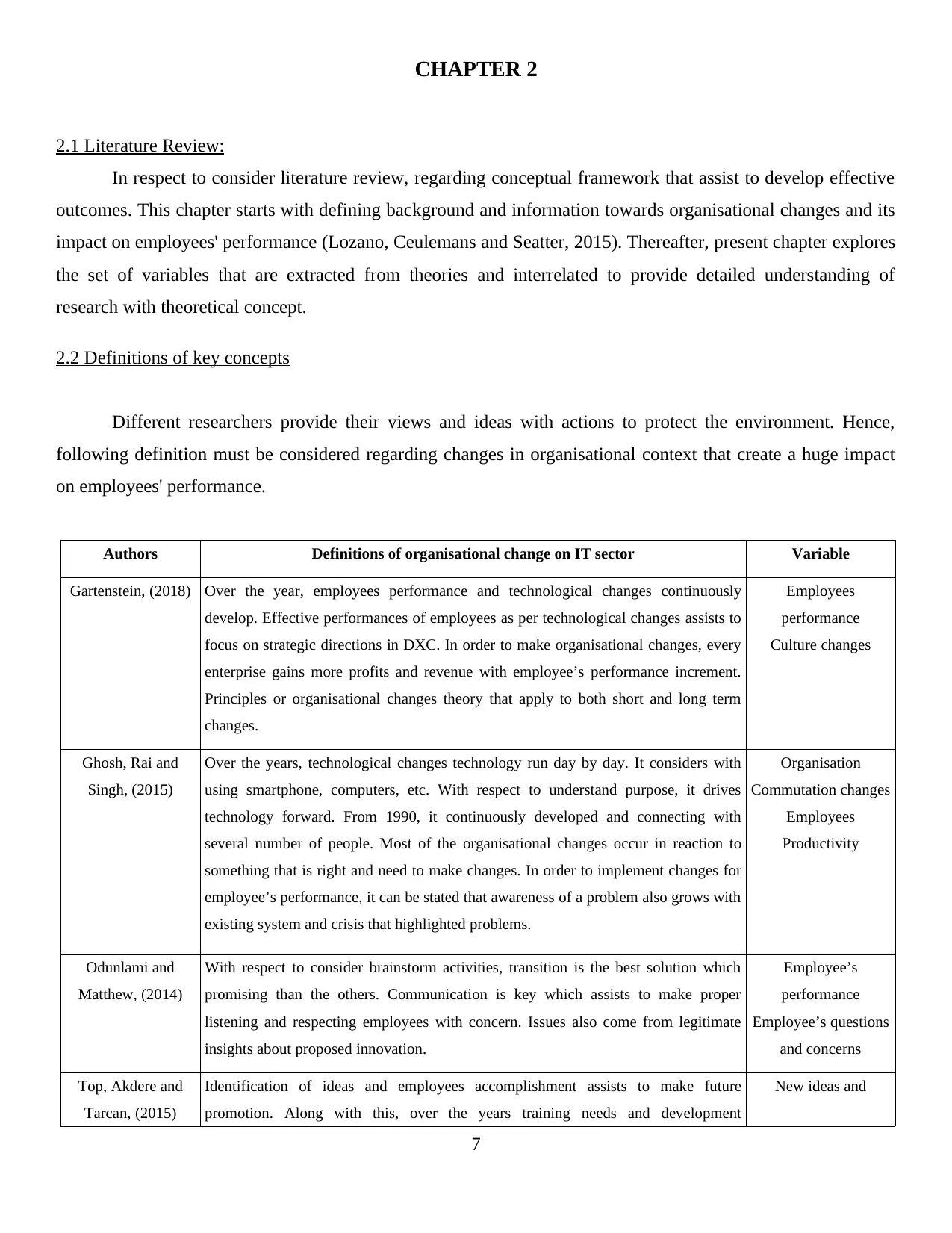
CHAPTER 2
2.1 Literature Review:
In respect to consider literature review, regarding conceptual framework that assist to develop effective
outcomes. This chapter starts with defining background and information towards organisational changes and its
impact on employees' performance (Lozano, Ceulemans and Seatter, 2015). Thereafter, present chapter explores
the set of variables that are extracted from theories and interrelated to provide detailed understanding of
research with theoretical concept.
2.2 Definitions of key concepts
Different researchers provide their views and ideas with actions to protect the environment. Hence,
following definition must be considered regarding changes in organisational context that create a huge impact
on employees' performance.
Authors Definitions of organisational change on IT sector Variable
Gartenstein, (2018) Over the year, employees performance and technological changes continuously
develop. Effective performances of employees as per technological changes assists to
focus on strategic directions in DXC. In order to make organisational changes, every
enterprise gains more profits and revenue with employee’s performance increment.
Principles or organisational changes theory that apply to both short and long term
changes.
Employees
performance
Culture changes
Ghosh, Rai and
Singh, (2015)
Over the years, technological changes technology run day by day. It considers with
using smartphone, computers, etc. With respect to understand purpose, it drives
technology forward. From 1990, it continuously developed and connecting with
several number of people. Most of the organisational changes occur in reaction to
something that is right and need to make changes. In order to implement changes for
employee’s performance, it can be stated that awareness of a problem also grows with
existing system and crisis that highlighted problems.
Organisation
Commutation changes
Employees
Productivity
Odunlami and
Matthew, (2014)
With respect to consider brainstorm activities, transition is the best solution which
promising than the others. Communication is key which assists to make proper
listening and respecting employees with concern. Issues also come from legitimate
insights about proposed innovation.
Employee’s
performance
Employee’s questions
and concerns
Top, Akdere and
Tarcan, (2015)
Identification of ideas and employees accomplishment assists to make future
promotion. Along with this, over the years training needs and development
New ideas and
7
2.1 Literature Review:
In respect to consider literature review, regarding conceptual framework that assist to develop effective
outcomes. This chapter starts with defining background and information towards organisational changes and its
impact on employees' performance (Lozano, Ceulemans and Seatter, 2015). Thereafter, present chapter explores
the set of variables that are extracted from theories and interrelated to provide detailed understanding of
research with theoretical concept.
2.2 Definitions of key concepts
Different researchers provide their views and ideas with actions to protect the environment. Hence,
following definition must be considered regarding changes in organisational context that create a huge impact
on employees' performance.
Authors Definitions of organisational change on IT sector Variable
Gartenstein, (2018) Over the year, employees performance and technological changes continuously
develop. Effective performances of employees as per technological changes assists to
focus on strategic directions in DXC. In order to make organisational changes, every
enterprise gains more profits and revenue with employee’s performance increment.
Principles or organisational changes theory that apply to both short and long term
changes.
Employees
performance
Culture changes
Ghosh, Rai and
Singh, (2015)
Over the years, technological changes technology run day by day. It considers with
using smartphone, computers, etc. With respect to understand purpose, it drives
technology forward. From 1990, it continuously developed and connecting with
several number of people. Most of the organisational changes occur in reaction to
something that is right and need to make changes. In order to implement changes for
employee’s performance, it can be stated that awareness of a problem also grows with
existing system and crisis that highlighted problems.
Organisation
Commutation changes
Employees
Productivity
Odunlami and
Matthew, (2014)
With respect to consider brainstorm activities, transition is the best solution which
promising than the others. Communication is key which assists to make proper
listening and respecting employees with concern. Issues also come from legitimate
insights about proposed innovation.
Employee’s
performance
Employee’s questions
and concerns
Top, Akdere and
Tarcan, (2015)
Identification of ideas and employees accomplishment assists to make future
promotion. Along with this, over the years training needs and development
New ideas and
7
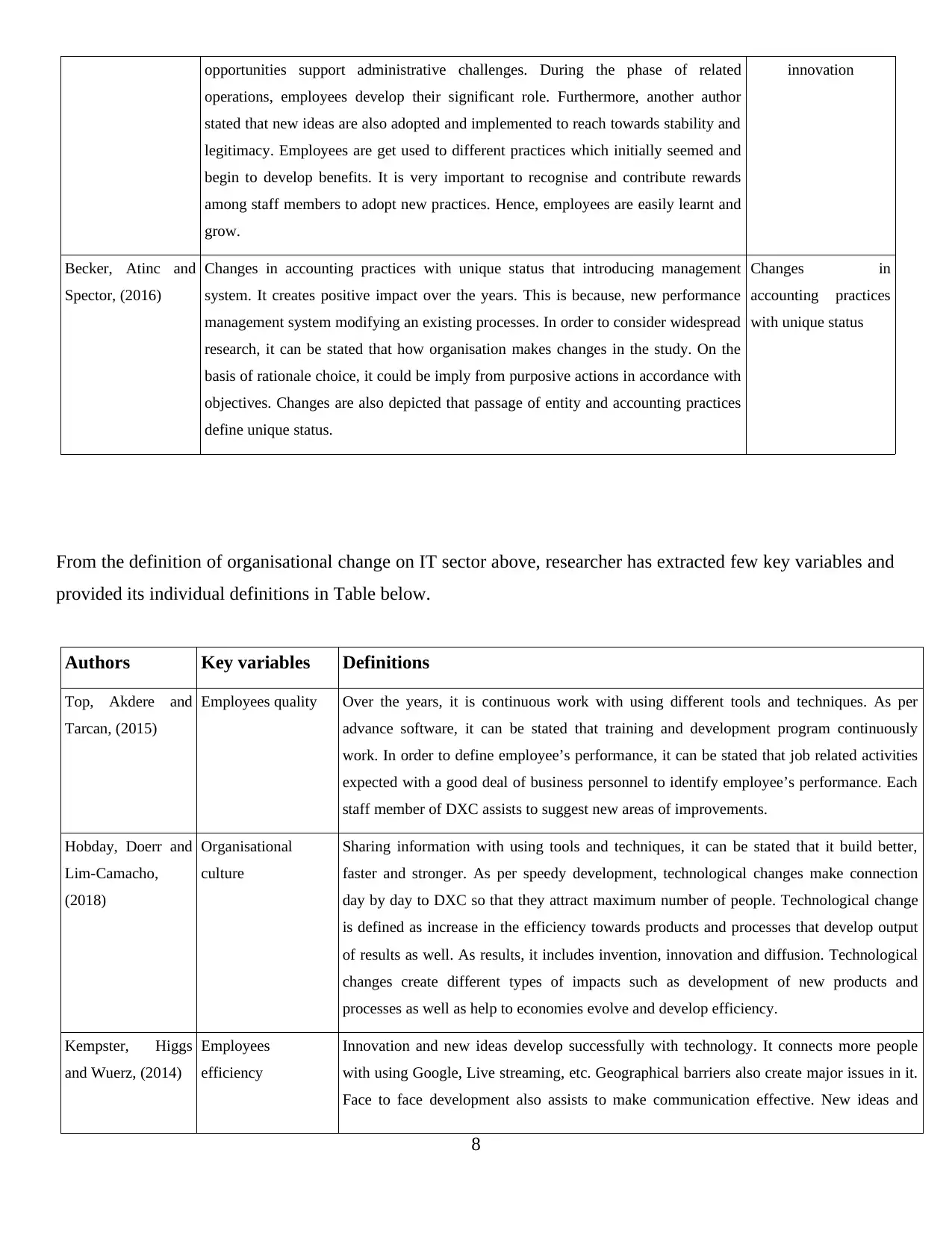
opportunities support administrative challenges. During the phase of related
operations, employees develop their significant role. Furthermore, another author
stated that new ideas are also adopted and implemented to reach towards stability and
legitimacy. Employees are get used to different practices which initially seemed and
begin to develop benefits. It is very important to recognise and contribute rewards
among staff members to adopt new practices. Hence, employees are easily learnt and
grow.
innovation
Becker, Atinc and
Spector, (2016)
Changes in accounting practices with unique status that introducing management
system. It creates positive impact over the years. This is because, new performance
management system modifying an existing processes. In order to consider widespread
research, it can be stated that how organisation makes changes in the study. On the
basis of rationale choice, it could be imply from purposive actions in accordance with
objectives. Changes are also depicted that passage of entity and accounting practices
define unique status.
Changes in
accounting practices
with unique status
From the definition of organisational change on IT sector above, researcher has extracted few key variables and
provided its individual definitions in Table below.
Authors Key variables Definitions
Top, Akdere and
Tarcan, (2015)
Employees quality Over the years, it is continuous work with using different tools and techniques. As per
advance software, it can be stated that training and development program continuously
work. In order to define employee’s performance, it can be stated that job related activities
expected with a good deal of business personnel to identify employee’s performance. Each
staff member of DXC assists to suggest new areas of improvements.
Hobday, Doerr and
Lim-Camacho,
(2018)
Organisational
culture
Sharing information with using tools and techniques, it can be stated that it build better,
faster and stronger. As per speedy development, technological changes make connection
day by day to DXC so that they attract maximum number of people. Technological change
is defined as increase in the efficiency towards products and processes that develop output
of results as well. As results, it includes invention, innovation and diffusion. Technological
changes create different types of impacts such as development of new products and
processes as well as help to economies evolve and develop efficiency.
Kempster, Higgs
and Wuerz, (2014)
Employees
efficiency
Innovation and new ideas develop successfully with technology. It connects more people
with using Google, Live streaming, etc. Geographical barriers also create major issues in it.
Face to face development also assists to make communication effective. New ideas and
8
operations, employees develop their significant role. Furthermore, another author
stated that new ideas are also adopted and implemented to reach towards stability and
legitimacy. Employees are get used to different practices which initially seemed and
begin to develop benefits. It is very important to recognise and contribute rewards
among staff members to adopt new practices. Hence, employees are easily learnt and
grow.
innovation
Becker, Atinc and
Spector, (2016)
Changes in accounting practices with unique status that introducing management
system. It creates positive impact over the years. This is because, new performance
management system modifying an existing processes. In order to consider widespread
research, it can be stated that how organisation makes changes in the study. On the
basis of rationale choice, it could be imply from purposive actions in accordance with
objectives. Changes are also depicted that passage of entity and accounting practices
define unique status.
Changes in
accounting practices
with unique status
From the definition of organisational change on IT sector above, researcher has extracted few key variables and
provided its individual definitions in Table below.
Authors Key variables Definitions
Top, Akdere and
Tarcan, (2015)
Employees quality Over the years, it is continuous work with using different tools and techniques. As per
advance software, it can be stated that training and development program continuously
work. In order to define employee’s performance, it can be stated that job related activities
expected with a good deal of business personnel to identify employee’s performance. Each
staff member of DXC assists to suggest new areas of improvements.
Hobday, Doerr and
Lim-Camacho,
(2018)
Organisational
culture
Sharing information with using tools and techniques, it can be stated that it build better,
faster and stronger. As per speedy development, technological changes make connection
day by day to DXC so that they attract maximum number of people. Technological change
is defined as increase in the efficiency towards products and processes that develop output
of results as well. As results, it includes invention, innovation and diffusion. Technological
changes create different types of impacts such as development of new products and
processes as well as help to economies evolve and develop efficiency.
Kempster, Higgs
and Wuerz, (2014)
Employees
efficiency
Innovation and new ideas develop successfully with technology. It connects more people
with using Google, Live streaming, etc. Geographical barriers also create major issues in it.
Face to face development also assists to make communication effective. New ideas and
8
⊘ This is a preview!⊘
Do you want full access?
Subscribe today to unlock all pages.

Trusted by 1+ million students worldwide
1 out of 83
Related Documents
Your All-in-One AI-Powered Toolkit for Academic Success.
+13062052269
info@desklib.com
Available 24*7 on WhatsApp / Email
![[object Object]](/_next/static/media/star-bottom.7253800d.svg)
Unlock your academic potential
Copyright © 2020–2025 A2Z Services. All Rights Reserved. Developed and managed by ZUCOL.



